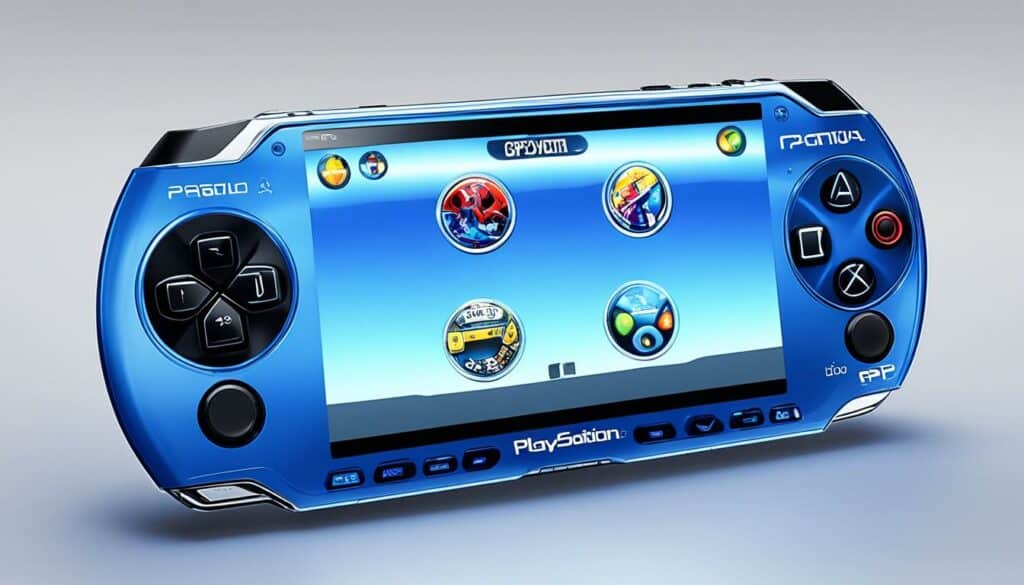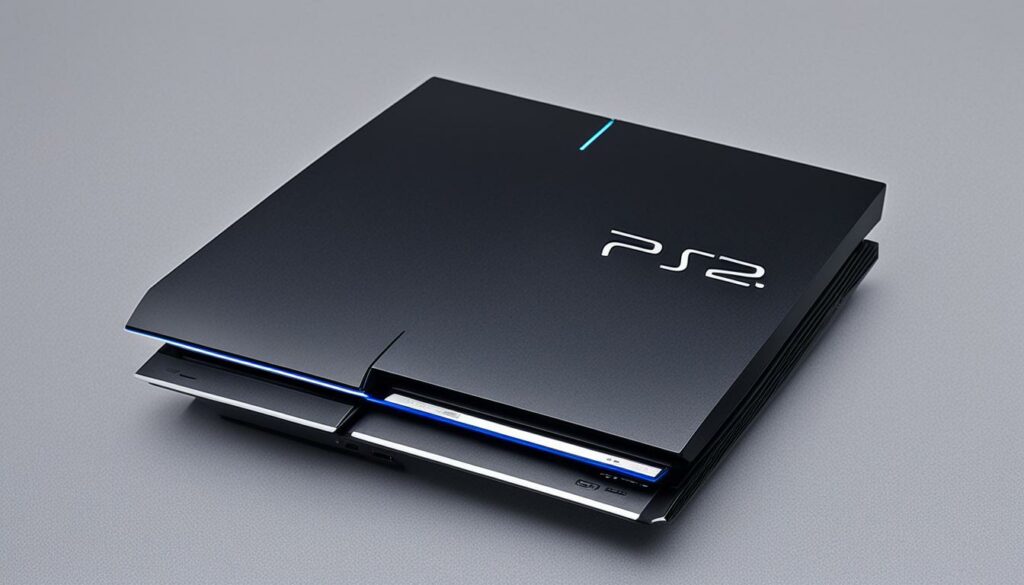Welcome to our complete guide on the PlayStation consoles! If you’re a gaming enthusiast or simply curious about the PlayStation brand, you may be wondering just how many PlayStation consoles have been released over the years. In this article, we’ll dive into the history and evolution of the PlayStation brand, highlighting each console’s unique features and contributions to the gaming industry.
The PlayStation brand has come a long way since its debut in 1994. Over the years, Sony has introduced a range of home video game consoles, handhelds, and even a smartphone. Each release has brought advancements in technology, design, and gaming experiences, captivating millions of players worldwide.
So, how many PlayStation consoles are there? Let’s take a closer look:
Key Takeaways:
- The PlayStation brand consists of five home video game consoles: PlayStation, PlayStation 2, PlayStation 3, PlayStation 4, and PlayStation 5.
- Two handheld consoles were released: PlayStation Portable (PSP) and PlayStation Vita (PS Vita).
- The PlayStation brand also includes a media center and a smartphone.
- The PlayStation 2 is the best-selling home console of all time, with over 155 million units sold.
- The PlayStation 5 is the latest console in the series, offering advanced graphics and backward compatibility.
Overview of PlayStation Consoles and Their Impact
In this section, we will explore the various PlayStation consoles released over the years and their impact on the gaming industry. From the iconic original PlayStation to the latest PlayStation 5, each console has brought innovative features and unforgettable gaming experiences to millions of players worldwide.
PlayStation Release Dates
Let’s take a trip down memory lane as we delve into the release dates of each PlayStation console:
- The original PlayStation was released in 1994, marking Sony’s entrance into the gaming world. It quickly gained popularity and sold over 100 million units. This fifth-generation console introduced gamers to incredible 3D graphics and immersive gameplay.
- The PlayStation 2, released in 2000, revolutionized the gaming industry. With its backward compatibility, players could enjoy their favorite PlayStation games while also exploring the vast library of new titles. Its DVD playback capabilities further added to its appeal. The PlayStation 2 went on to become the best-selling console of all time, with over 155 million units sold.
- In 2006, Sony unveiled the PlayStation 3, bringing high-definition gaming and Blu-ray technology to the forefront. The console’s powerful hardware and robust online services opened up new possibilities for gamers. With features like social gaming and multimedia support, the PlayStation 3 sold over 87.4 million units.
- The PlayStation 4, released in 2013, continued Sony’s tradition of innovation. This eighth-generation console focused on exclusives, social interaction, and multimedia capabilities. With a vast library of games and a strong online community, the PlayStation 4 sold over 102.8 million units, solidifying its position as one of the most successful consoles.
- The PlayStation 5, released in 2020, represents the next generation of gaming. Packed with advanced graphics, a lightning-fast solid-state drive, and incredible loading speeds, the PlayStation 5 delivers unparalleled gaming experiences. Its backward compatibility allows players to enjoy their favorite PlayStation 4 titles on the new console. The PlayStation 5 has already made a splash in the gaming world and is poised to shape the future of gaming.
Pioneering the Gaming Industry
The PlayStation consoles have made a significant impact on the gaming industry, pushing boundaries and shaping the way we play. With each new iteration, Sony has introduced groundbreaking technologies and features that have captivated players worldwide.
The PlayStation series has always been at the forefront of innovation, bringing gamers the latest technologies and immersive experiences. From the introduction of 3D graphics to the integration of online services and multimedia capabilities, the PlayStation consoles have redefined gaming time and time again.
Take a look at this table summarizing the release dates and key features of each PlayStation console:
| Console | Release Date | Key Features |
|---|---|---|
| PlayStation | 1994 | 3D graphics, extensive game library |
| PlayStation 2 | 2000 | Backward compatibility, DVD playback |
| PlayStation 3 | 2006 | Blu-ray technology, social gaming services |
| PlayStation 4 | 2013 | Exclusives, social interaction, multimedia playback |
| PlayStation 5 | 2020 | Advanced graphics, solid-state drive, backward compatibility |
Stay tuned as we explore the evolution of PlayStation handheld consoles in the next section.
Evolution of PlayStation Handheld Consoles
The PlayStation brand has not only produced innovative home consoles but also ventured into the world of handheld gaming. Let’s take a closer look at the evolution of PlayStation handhelds, from the pioneering PlayStation Portable (PSP) to its successor, the PlayStation Vita (PS Vita).
The PlayStation Portable (PSP)

The PlayStation Portable, released in 2004, revolutionized handheld gaming with its powerful hardware and a unique lineup of games. With its internet connectivity, gamers could access online multiplayer, browse the web, and even stream media. The PSP garnered immense popularity, selling over 80 million units worldwide.
Offering a portable gaming experience like no other, the PSP allowed players to enjoy PlayStation-quality games on the go. Its vibrant screen, ergonomic design, and extensive library of titles made it a favorite among gamers of all ages. From thrilling action-adventure games to immersive RPGs, the PSP offered an impressive handheld gaming experience.
Despite the success of the PSP, its successor, the PlayStation Vita (PS Vita), faced certain challenges in the market.
The PlayStation Vita (PS Vita)
Released in 2011, the PlayStation Vita combined powerful hardware with cutting-edge features. It boasted a high-resolution OLED screen, innovative touch controls, and dual analog sticks, providing a console-like gaming experience in a portable device. However, despite its technical capabilities, the PS Vita struggled commercially.
One of the main factors contributing to the PS Vita’s commercial challenges was the lack of AAA (triple-A) titles, which are high-budget, highly anticipated games. While the PS Vita had a library of games, it didn’t have the same level of extensive exclusive titles as its predecessor. This impacted its appeal to a wider audience and led to lower sales compared to the PSP.
In light of these challenges, Sony has no plans to develop another handheld console. However, the legacy of the PlayStation handhelds remains, as they introduced a new dimension to portable gaming and left a lasting impact on the industry.
The PlayStation Portable and PlayStation Vita revolutionized handheld gaming, showcasing the power of PlayStation consoles on the go. While the PSP captured the hearts of gamers worldwide with its extensive library and internet connectivity, the PS Vita faced commercial challenges due to the lack of AAA titles. Although there won’t be any new handheld consoles from Sony, the legacy of PlayStation handhelds continues to awe and inspire.
PlayStation Variants and Slim Models
Sony has released various PlayStation variants and slim models over the years, providing gamers with updated designs and enhanced features. Let’s take a look at some of the notable PlayStation consoles:
PlayStation 2 Slim

The PlayStation 2 Slim, launched in 2004, introduced a slimmer and more compact design compared to the original PlayStation 2 (PS2) console. Apart from the sleeker appearance, the PS2 Slim also featured a built-in ethernet port for easy online connectivity and quieter operation. It became a popular choice for gaming enthusiasts looking for an upgraded version of the PS2.
PlayStation 3 Slim
The PlayStation 3 Slim, released in 2009, marked a redesign of the original PlayStation 3 (PS3) console. It boasted a lighter and more streamlined form factor, making it easier to fit into entertainment centers. The PS3 Slim retained the powerful hardware capabilities of its predecessor while offering a more efficient and energy-conscious gaming experience.
PlayStation 3 Super Slim
In 2012, Sony introduced the PlayStation 3 Super Slim, which was 25% lighter and more compact than the PS3 Slim. It featured a manual sliding disc cover, contributing to its space-saving design. The PS3 Super Slim was renowned for its affordability and continued support for a wide range of games and multimedia functionalities.
PlayStation 4 Slim
The PlayStation 4 Slim, released in 2016, provided an upgraded version of the original PlayStation 4 (PS4) console. This slimmer and lighter iteration offered a more efficient and power-friendly gaming experience. The PS4 Slim retained the same performance capabilities as the original console but with a more compact design that fit seamlessly into modern entertainment setups.
| PlayStation Variant | Release Year | Key Features |
|---|---|---|
| PlayStation 2 Slim | 2004 | Slimmer design, built-in ethernet port, quieter operation |
| PlayStation 3 Slim | 2009 | Lighter design, redesigned form factor |
| PlayStation 3 Super Slim | 2012 | 25% lighter, manual sliding disc cover |
| PlayStation 4 Slim | 2016 | Smaller, lighter, more power-efficient |
These slim models offered gamers a more convenient and space-saving gaming experience while retaining the performance and capabilities of their respective original consoles.
PlayStation 5 and Its Features
The PlayStation 5, released in 2020, is the latest console in the series. It offers an array of impressive features that elevate the gaming experience to new heights.
One notable feature of the PlayStation 5 is its stunning graphics. With advanced hardware and ray-tracing technology, games on the PS5 are visually immersive and lifelike. Players can enjoy breathtaking realism and detailed environments like never before.
Another highlight of the PS5 is its solid-state drive (SSD), which significantly reduces loading times. Games load faster, allowing for seamless transitions between gameplay and reducing those frustrating wait times. The SSD also enables faster installation and updates, ensuring players can jump right into the action.
The PlayStation 5 supports 4K resolution, providing crisp and vibrant visuals. Whether you’re exploring expansive open worlds or engaging in fast-paced action, the enhanced clarity adds an extra layer of detail to every gaming moment.
For gamers seeking smooth and responsive gameplay, the PS5 offers up to 120 frames per second (FPS) on supported titles. This higher frame rate delivers ultra-fluid motion, making games feel incredibly responsive and immersive.
The PlayStation 5 is available in two versions: the Standard PS5 with a disc drive and the PS5 Digital Edition without a disc drive. This allows players to choose the option that best suits their preferences and gaming habits.
Furthermore, the PS5 boasts backward compatibility with most PlayStation 4 titles. This means that players can enjoy their existing game library on the new console, allowing for a seamless transition and the ability to revisit beloved games from the previous generation.
| PlayStation 5 Features | Description |
|---|---|
| Advanced Graphics | Stunning visuals and ray-tracing technology |
| Solid-State Drive | Reduced loading times and faster installation |
| 4K Resolution | Crisp and vibrant visuals |
| Up to 120 FPS | Smooth and responsive gameplay |
| Standard and Digital Editions | Choose between a disc drive or digital-only console |
| Backward Compatibility | Play most PlayStation 4 titles on the PS5 |
With its cutting-edge features and innovative design, the PlayStation 5 represents the next generation of gaming. Whether you’re an avid gamer or new to the PlayStation family, the PS5 is sure to provide an unforgettable gaming experience.
PlayStation Network and Online Services
The PlayStation Network (PSN) is a robust online service that provides a wide range of features and benefits to PlayStation console owners. With over 110 million registered users, PSN offers a rich and immersive online gaming experience.
One of the key components of the PlayStation Network is the PlayStation Store. This digital marketplace allows users to browse, purchase, and download a vast library of games, add-ons, and multimedia content directly to their consoles. From AAA titles to indie gems, the PlayStation Store offers something for every gamer.
Additionally, PlayStation Plus is a subscription-based service available through PSN. With PlayStation Plus, users gain access to exclusive discounts, free monthly games, early access to demos and betas, and cloud storage for game saves. It’s a fantastic way to enhance your gaming experience and get more value out of your PlayStation console.
Another noteworthy feature of the PlayStation Network is PlayStation Home. This social gaming networking service allows users to create avatars, customize virtual spaces, and interact with other players in a virtual community. Whether it’s joining virtual events, playing mini-games, or exploring themed spaces, PlayStation Home offers a unique and immersive social experience.
Furthermore, PlayStation Mobile brings the world of PlayStation to mobile devices. With this service, users can enjoy PlayStation content on their smartphones and tablets, extending their gaming experience beyond the console.
The seventh-generation PlayStation products, such as the PlayStation 3 and PlayStation Portable, use the XrossMediaBar (XMB) as their graphical user interface. The XMB provides an intuitive and easy-to-navigate menu system, allowing users to access various features and settings effortlessly.
“The PlayStation Network creates a vibrant and interconnected community where gamers can come together, play, and share their gaming experiences. Whether it’s browsing the PlayStation Store, enjoying the benefits of PlayStation Plus, socializing in PlayStation Home, or accessing PlayStation content on mobile devices, the PlayStation Network enriches the overall gaming experience.”
Summary:
- The PlayStation Network offers a variety of online services and features for PlayStation console owners.
- The PlayStation Store allows users to browse, purchase, and download games and multimedia content.
- PlayStation Plus offers subscription-based benefits, including discounts, free games, and cloud storage.
- PlayStation Home provides a virtual social gaming experience, allowing users to interact and customize virtual spaces.
- PlayStation Mobile extends the PlayStation experience to mobile devices.
- The XrossMediaBar (XMB) serves as the graphical user interface for seventh-generation PlayStation consoles.
PlayStation Studios and Exclusive Games
PlayStation Studios, owned by Sony Interactive Entertainment, is a group of studios that specializes in developing exclusive games for PlayStation consoles. These studios have created a strong lineup of first-party games that have become iconic within the gaming industry.
One of the standout franchises from PlayStation Studios is Uncharted, an action-adventure series that follows the adventures of the charismatic treasure hunter Nathan Drake. With its cinematic storytelling, breathtaking visuals, and thrilling gameplay, Uncharted has captured the hearts of players around the world.
God of War is another highly acclaimed series developed by PlayStation Studios. This epic action game follows the journey of Kratos, a Spartan warrior who seeks revenge against the gods of Olympus. Known for its intense combat, immersive world-building, and emotional storytelling, God of War has become a beloved franchise among PlayStation fans.
Gran Turismo, a racing simulation series, is renowned for its realistic graphics, meticulous attention to detail, and extensive selection of cars and tracks. Developed exclusively for PlayStation consoles, Gran Turismo has set the standard for racing games and has garnered a dedicated fan base over the years.
“PlayStation Studios is committed to delivering unique gaming experiences that can only be found on PlayStation consoles. By nurturing talented developers and fostering creative partnerships, we strive to push the boundaries of interactive entertainment.”
In addition to these flagship titles, PlayStation Studios has produced a wide range of other exclusive games, catering to various genres and player preferences. From critically acclaimed titles like The Last of Us and Bloodborne to innovative indies like Journey and Concrete Genie, PlayStation Studios continues to deliver diverse and compelling gaming experiences.
Sony also releases budget re-releases of games under different names for each region, such as Greatest Hits, Platinum, Essentials, and The Best selection. These editions offer players a chance to experience popular titles at a more affordable price.
Through PlayStation Studios’ dedication to quality and innovation, gamers can expect an ever-expanding library of exclusive games that showcase the full potential of PlayStation consoles.
Conclusion
Sony’s PlayStation consoles have enjoyed immense success, with each iteration pushing the boundaries of technology, design, and gaming experiences. From the groundbreaking original PlayStation to the highly anticipated PlayStation 5, Sony has consistently delivered innovative gaming platforms that have captivated players around the globe. With an impressive console count of five, the PlayStation brand has become synonymous with exceptional gaming.
Over the years, Sony has continuously raised the bar with each new console release. The PlayStation 2, still holding the crown as the best-selling console of all time, revolutionized the gaming industry with its backward compatibility and DVD playback capabilities. The PlayStation 4, with its focus on exclusives and social interaction, further solidified Sony’s domination in the gaming market.
As gamers eagerly anticipate the future of PlayStation consoles, Sony shows no signs of slowing down. With the powerful PlayStation 5, featuring advanced graphics, lightning-fast load times, and backward compatibility with PlayStation 4 titles, players are in for an extraordinary gaming experience. The PlayStation brand’s impact on the gaming industry cannot be understated, and it will continue to shape the future of gaming for years to come.
When it comes to the best PlayStation console, it ultimately comes down to personal preference. Each console has its unique strengths and standout features. From the nostalgia-inducing PlayStation 1 to the cutting-edge PlayStation 5, Sony has consistently delivered quality consoles that cater to different generations of gamers. Whether you appreciate the classic charm of the earlier models or crave the technological advancements of the latest generation, Sony’s PlayStation consoles offer something for everyone..
FAQ
How many PlayStation consoles are there?
The PlayStation brand consists of five home video game consoles, namely the original PlayStation, PlayStation 2, PlayStation 3, PlayStation 4, and the latest console, PlayStation 5.
What are the release dates of the PlayStation consoles?
The PlayStation consoles were released as follows: PlayStation (1994), PlayStation 2 (2000), PlayStation 3 (2006), PlayStation 4 (2013), and PlayStation 5 (2020).
What is the best-selling PlayStation console of all time?
The PlayStation 2, released in 2000, is the best-selling home console of all time with over 155 million units sold.
Are there any handheld PlayStation consoles?
Yes, there are two handheld PlayStation consoles: the PlayStation Portable (PSP) released in 2004 and the PlayStation Vita (PS Vita) released in 2011.
Can I buy a PlayStation console online?
Yes, you can buy PlayStation consoles online from various retailers and the official PlayStation website.
Which PlayStation console is considered the best?
The best PlayStation console is subjective and depends on personal preferences. Each console offers unique features and capabilities.
What are the key features of the PlayStation 5?
The PlayStation 5 features impressive graphics, a solid-state drive, 4K resolution, and up to 120 FPS on supported titles. It also has backward compatibility with most PlayStation 4 titles.
What is PlayStation Network and what services does it offer?
PlayStation Network is an online service that includes the PlayStation Store for purchasing and downloading games and multimedia, PlayStation Plus for subscription-based services, and PlayStation Home, a social gaming networking service.
What are PlayStation Studios and what kind of games do they develop?
PlayStation Studios is a group of studios owned by Sony Interactive Entertainment that exclusively develops games for PlayStation consoles. They create a strong lineup of first-party games, including popular titles like Uncharted, God of War, and Gran Turismo.
How has the PlayStation brand contributed to the gaming industry?
The PlayStation brand has a rich history of releasing successful consoles that have brought advancements in technology, design, and gaming experiences. Sony’s innovation has continuously shaped the gaming industry and captivated gamers worldwide.









